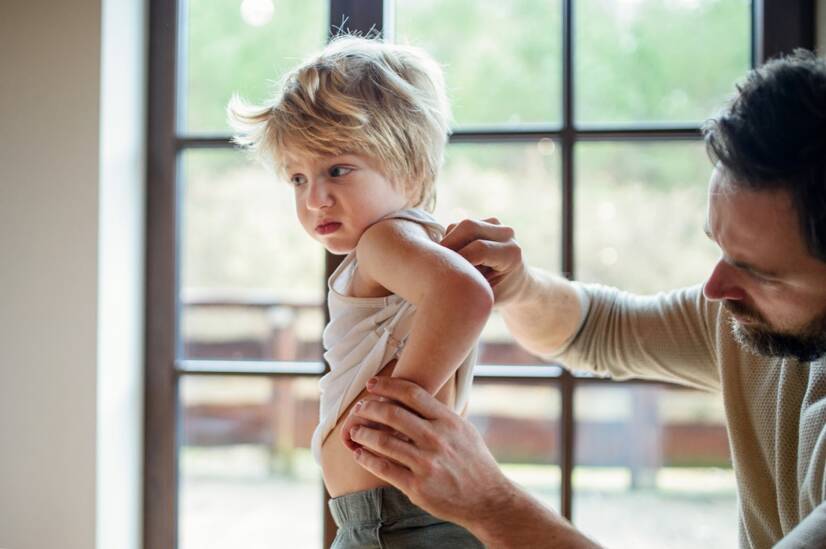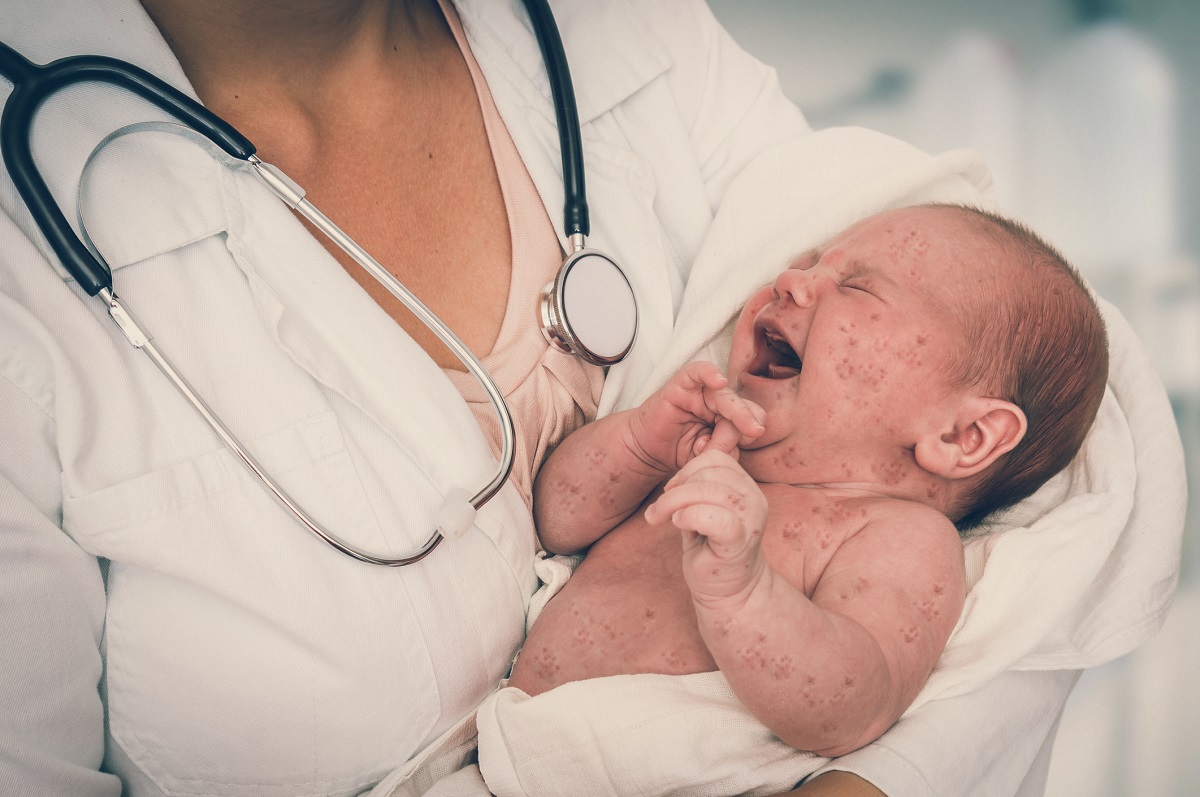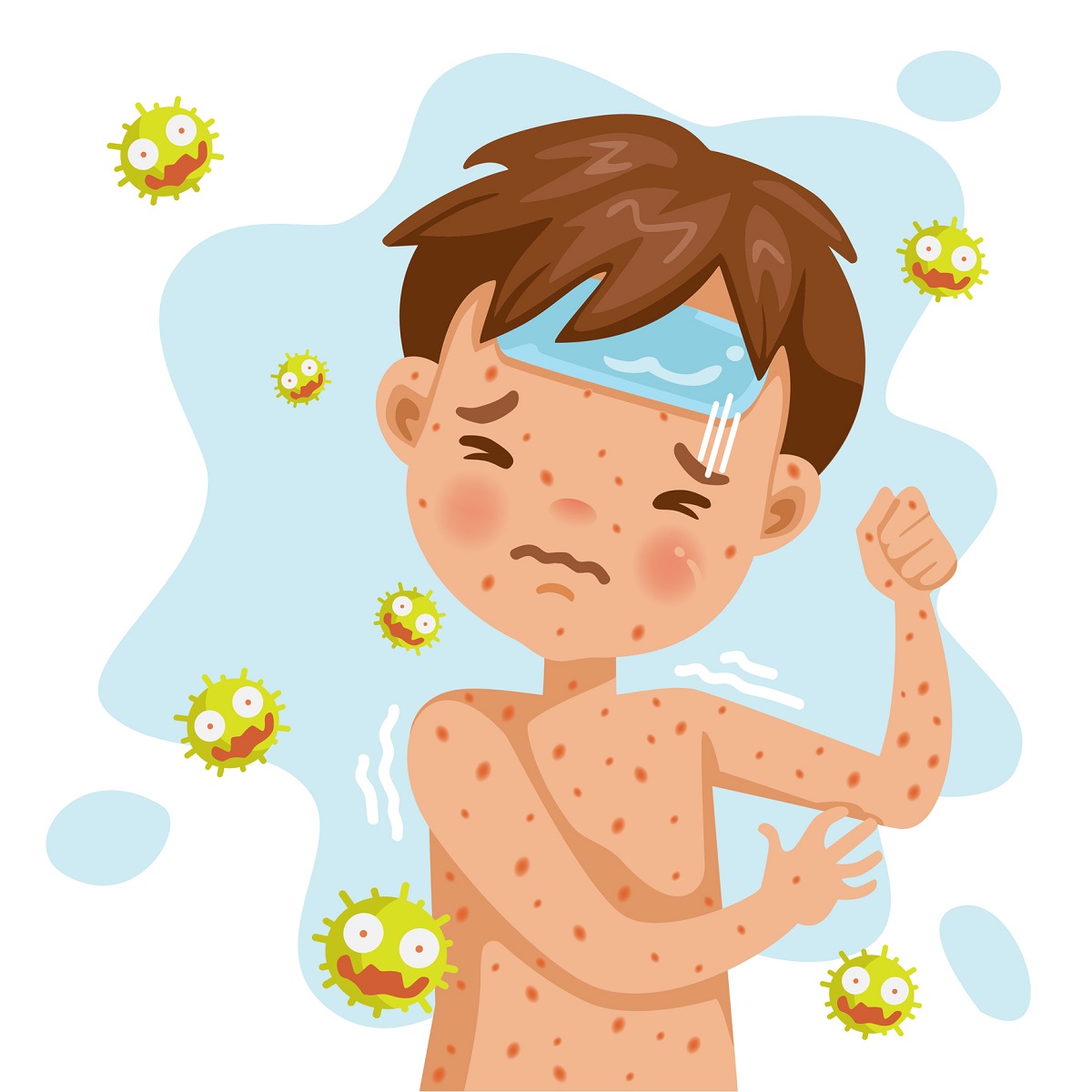- Health and Disease Clinic: Katarína Kopecká, Petr Kopecký
- unilabs.sk - Anti rubeola IgM
- ruvztv.sk - Rubella
- uvzsr.sk - Bulletin of the Ministry of Health 2008
- pediatriepropraxi.cz - Viral exanthems of childhood: doc. MUDr. Dalibor Sedláček, CSc., MUDr. Věra Štruncová
- solen.sk - Infectious diseases accompanied by exanthema: MUDr. Klára Martinásková, PhD., MUDr. Karolína Vorčáková, PhD.
- webmd.com - Rubella
- nhs.uk - Rubella (German measles)
- kidshealth.org - Rubella (German Measles)
- who.int - Rubella
Rubella: Why does it occur and what are the symptoms?

Rubella is an infectious viral disease. It manifests itself as a skin rash to seeding all over the body. Nowadays, thanks to regular vaccination, this disease is relatively rare.
Most common symptoms
- Muscle Pain
- Malaise
- Headache
- Joint Pain
- Painful Lymph Nodes
- Fever
- Diarrhoea
- Rash
- Indigestion
- Petechie
- Full nose
- Buds
- Dry cough
- Itchy skin
- Fatigue
- Redness of the conjunctivae
- Winterreise
- Enlarged lymph nodes
- Increased body temperature
Characteristics
Transmission from person to person occurs by inhaling a droplet of the virus when an infected person coughs or sneezes.
Rubella can also be contracted by sharing food, drinks with an infected person, contact with the saliva of an infected person, or rarely, infected objects that you have touched and transferred the infection to your mouth or eyes by touching your hands.
It is most common in children and adolescents in the spring time.
The incubation period is 14 to 21 days. The disease is manifested by a typical rash on the skin.
In most cases, the disease is not dangerous. After contracting it, a person develops lifelong immunity.
The incidence of the disease is worldwide. It mainly affects children aged 6-12 years.
The disease can take two forms
Congenital - When a pregnant woman is infected, the virus passes through the placenta to the embryo, the fetus, where it can cause serious disorders.
Acquired - After infection with rubella virus, it is manifested by increased temperature, enlarged lymph nodes and skin seeding. Acquired disease leaves lifelong immunity.
Rubella in childhood
Rubella in childhood is a non-serious viral infection.
They begin subtly as inflammation of the nasopharynx with an elevated temperature.
The rash appears almost simultaneously on the face, neck and trunk. On the extremities, the rash is less pronounced.
The rash is very similar to measles. In contrast, it is smaller and paler and lasts 2-3 days. Along with the rash, swelling of the nodes on the neck and head also occurs.

Rubella in adulthood
Although rubella is typically contracted mainly in infancy, it can also occur in adulthood, especially in unvaccinated persons.
In adults, the disease can have a more complicated course with more severe symptoms.
Rubella in pregnancy
In unvaccinated pregnant women, complications tend to be very serious.
Infection with the virus during pregnancy can cause miscarriage, fetal harm, stillbirth or the birth of a baby with congenital rubella syndrome.
In pregnancy, mother-to-child transmission occurs mainly in the first three months of pregnancy.
The course of rubella in pregnancy depends mainly on the immunity of the mother during pregnancy at the time of infection.
When the mother is infected, even if she is asymptomatic in the first month, 50% of the fetus is affected. In the second month, the risk is 25%, in the third trimester 10% and in the fourth month less than 5% of the newborn is affected.
Rubella vaccination
Anyone who has not yet contracted the disease or has not been vaccinated can become infected.
This viral infection can be prevented by vaccination with the MMR vaccine, a combination vaccine against 3 diseases: measles, rubella and mumps.
Read also our article:
Measles or chickenpox? Here's how to spot them easily
The vaccine is completely safe and, above all, effective, with almost no side effects.
As a side effect, fever, swelling, pain and redness at the injection site may occur after vaccination. Some people may develop a mild measles-like rash around day 7 to 14 after vaccination, which resolves spontaneously within 1 to 3 days.
Two doses of the vaccine are recommended for full protection.
The first dose is given to children aged 15-18 months and the second dose at age 11 years.
The second dose can be given as early as one month after the first dose.
Vaccination during pregnancy is not recommended at all. It is also not recommended to become pregnant for at least three months after vaccination.
Causes
The source of infection is the infected person. The highest infectivity is in the period of one week before the appearance of the rash and about 5 days after it.
Symptoms
If symptoms do occur, they may be mild and few in number.
The first typical symptom that parents first notice in a child is a rash.
The rash looks pink to red in the form of spots.
The spots may join together to form a uniformly colored rash that tends to itch.
The rash usually lasts for 3 days. After it has disappeared, very fine scales may peel from the skin.
Children often also have a raised temperature and enlarged nodules.
Typical and associated manifestations of rubella
The typical and most common symptom is the appearance of a red or pink blotchy rash. It first appears as a butterfly on the face or behind the ears and spreads over the rest of the body, trunk and limbs. On the limbs, the rash tends to be inconspicuous.
The rash takes the form of small dots and spots, especially on the face, neck and torso.
The rash occurs in 50-80 % of cases.
- On white skin, the rash looks red or pink.
- On brown or dark skin it is less visible, but the surface of the skin is rough and bumpy.

There is also swelling of the lymph nodes behind the ears and on the neck. The nodes are swollen and tender.
Adults may also experience joint pain and inflammation lasting 3-10 days. It is more common in women.
Elevated temperature and fever (usually up to 38.5 °C).
Other symptoms, especially in adolescents and adults:
- Rhinorrhea, stuffy nose
- Inflamed or reddened conjunctivae
- Sore throat, cough
- Nausea
- Headache
- Muscle pain
In very rare cases, the infection can lead to ear infections and swelling of the brain, which will manifest:
- Prolonged headache
- Stiff neck
- Ear pain
The symptoms of rubella and measles are very similar.
Measles is an infectious disease characteristic of childhood.
Comparison of symptoms of rubella and measles (table)
| Symptoms | Rubella | Measles |
| Rash | Small dots to spots | Pimple above the skin surface up to 1 cm |
| Localization of the rash | Starts on face, progresses to neck, trunk and body | Progresses from scalp, behind ears, face, to trunk and extremities |
| Swollen lymph nodes | + | - |
| Elevated temperature, fever | + (usually up to 38 °C) | + (high temperatures up to 40 °C) |
| Rhinorrhea, stuffy nose | + | + |
| Throat pain | + | - |
| Cough | + | + mostly dry, barking |
| Nausea, lack of appetite | + | + |
| Inflamed, red conjunctivae | + | + |
| Headache | + | - |
| Lightheadedness | - | + |
| Muscle pain | + | + |
| Joint pain and swelling | + | - |
| White patches on the lining of the oral cavity | - | + |
| Diarrhoea | - | + |
| Fatigue and pain throughout the body | - | + |
Congenital rubella syndrome
Occurs in a fetus whose mother had rubella virus during pregnancy. The baby is born with congenital rubella syndrome.
It is manifested by the following symptoms:
- congenital heart defects
- eye disorders
- cataracts
- glaucoma - glaucoma
- retinopathy pigmentosa - disease of the retina
- ear disorder
- deafness
- hearing loss
- purpura - multiple punctate haemorrhages in the skin
- dental anomalies
- microcephaly - underdevelopment of the skull, smaller head size
- myocarditis - inflammatory disease of the heart
- hepatitis - inflammation of the liver
- meningoencephalitis - inflammation of the brain and meninges
- osteoporotic changes of the long bones
Children are born with lower birth weights and often do not thrive developmentally.
Babies can be infectious for as long as a month after birth by shedding saliva, snot and urine. In exceptional cases, they can be infectious for the first year and in the case of cataracts up to the age of 3 years.
Diagnostics
When rubella infection is suspected, blood is taken for serological examination to detect rubella antibodies.
IgM and IgG antibodies are elevated early in the infection.
After the disease has passed, the levels of IgG antibodies in the blood increase up to fourfold. They persist throughout life and provide immunity against reinfection with rubella.
IgM antibodies are indicative of acute infection.
The following table shows the results of the rubella IgG blood test (IU/ml)
| Value less than 5 | Negative |
| More than 5 and less than 9.9 | Borderline values |
| Above 10 | Positive |
Results of rubella IgM (index) blood test values listed in the table
| Below 0.8 | Negative |
| Above 0.8 to 0.99 | Borderline values |
| Above 1.0 | Positive |
Course
After infection, the virus spreads throughout the body in about 5-7 days.
Symptoms appear 2 to 3 weeks after exposure to the virus.
The most infectious period is the week before and 5 days after the rash appears.
How does rubella virus disease progress in the human body?
After rubella infection, the virus multiplies in the mucous membranes of the nasopharynx and upper respiratory tract. It manifests as an inflammatory disease of the nasopharynx.
There may be an increase in temperature up to a fever lasting about 1-2 days.
From the nasopharynx, the infection spreads to the lymph nodes and blood, where it causes a viral infection.
Swelling of the cervical nodes, under the ear and in the nape of the neck occurs.
The viral infection lasts up to 9 days. The virus is eliminated from the body through the kidneys.
Meanwhile, the virus moves to the skin, where a rash develops. The first antibodies appear in the blood.
In addition, the virus can enter the joints, where it causes inflammatory changes.
After the rash has spread to the body, the face usually clears up.
The duration of the rash is approximately 1 to 3 days.

Swollen nodules may persist for a week or more and joint pain for more than 2 weeks.
Children recover quickly most often within a week, adults may take longer to recover.
If a woman becomes infected with rubella during the first three months of pregnancy, there is a high risk of infection.
There is then a high risk of miscarriage, stillbirth or damage to the fetus, which is born with rubella syndrome. This leads to deafness, blindness or mental retardation and heart defects in the fetus.
How it is treated: Zarděnky
What is the treatment for rubella and what drugs work?
Show moreZarděnky is treated by
Other names
Interesting resources










